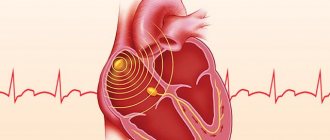Why is low blood pressure in an elderly person no less dangerous than high blood pressure?
Both conditions are dangerous - hypotension and hypertension. Doctors cannot give a definite answer as to whether high blood pressure or low blood pressure is worse. For a long time, there was an opinion that only high blood pressure is dangerous, since it puts a serious strain on the heart and this negatively affects its functioning. That is why older people with hypertension are often diagnosed with cardiovascular diseases, and they often suffer from strokes, heart attacks and other complications.
However, very low blood pressure in an elderly person is no less dangerous - with a lack of oxygen, the brain, heart, kidneys, and gastrointestinal tract cannot function normally. The result is the gradual death of organ cells.
Complications of hypotension include:
- Injuries sustained by older people during fainting conditions. They are often very strong.
- Ischemic stroke. It becomes a consequence of chronic lack of blood supply.
- Cardiogenic shock, myocardial infarction. Occurs when there is insufficient blood supply to the heart.
- Senile dementia (dementia). Develops as a result of a disturbance in the thought process due to frequent changes in blood pressure.
- Loss of sensation in limbs in older people. It becomes a consequence of disruptions occurring in the venous and arterial blood supply.
Hypotension that lasts for a long time can cause severe arterial hypertension.
We recommend
“Vitamins for elderly people over 70: which ones are needed first” Read more
Symptoms and signs
The main danger of hypotension is organ hypoxia, when they do not receive the required amount of oxygen. Nerve cells are primarily affected. With chronic low blood pressure, cerebral circulation suffers.
This is manifested by the following signs:
- dizziness appears, mental abilities and memory decrease;
- pulse increases to 80 beats per minute and above;
- frequent fainting and interruptions in cardiac activity;
- headaches and visual disturbances;
- overall performance decreases;
- rapid fatigue even with minor physical and mental stress;
- It gets dark before your eyes, and you get a feeling of flies flickering.
There is also a violation of the filtering ability of the kidneys, which leads to disturbances in the outflow of urine. This causes the accumulation of waste and toxins in the body. This condition manifests itself as bags under the eyes and a puffy face.
Causes of low blood pressure in older people
Low blood pressure in older people can be either a primary, underlying disease or a symptomatic consequence of other diseases. Primary hypotension is called when this condition is not accompanied by other diseases. Otherwise, we are talking about symptomatic hypotension.
Many people are interested in why low blood pressure occurs in an elderly person, what is the cause of this condition. It is difficult to figure out what to do when diastolic pressure is low. The causes in older people directly depend on the type of hypotension. The acute form is a consequence of heart attacks, blood loss, intracardiac blockade, severe arrhythmia, and an allergic reaction. In case of acute hypotension, it is important to provide first aid to the person in a timely manner.
Primary hypotension is an independent disease manifested in the form of neurocirculatory asthenia.
Physiological hypotension is a hereditary disease; in other words, it is the body’s predisposition to low blood pressure. An elderly person is already accustomed to this condition, and since the readings are not much lower than normal, they are practically the norm for low blood pressure in older people.
The main reason for low blood pressure in an elderly person is prolonged psycho-emotional stress, which gives rise to neurosis of the vasomotor centers of the brain. Severe stress, in which a person is under for a long time, causes a drop in pressure, and, as a result, primary hypotension. It is also possible that this disease may develop due to an overdose of medications for hypertension. Another cause of hypotension is a lack of vitamins B5, C, E.
Causes of primary hypotension:
- frequent neuroses;
- psychotrauma;
- chronic lack of sleep and fatigue;
- depressive states of a person and apathy towards everything.
Causes of symptomatic hypotension:
- stomach ulcer;
- arrhythmia;
- rheumatism;
- anemia;
- cervical osteochondrosis;
- problems with blood circulation;
- heart failure;
- hepatitis, etc.
We recommend
“First aid for the elderly: what you need to know about it” Read more
Is this condition dangerous?
For prolonged hypotension, a doctor's consultation is necessary. Otherwise, the process may become chronic.
The danger of pressure 80 to 40 and even 85 to 55 is that a person may not feel it for a long time. While the pathological processes in his body continue to progress.
The most dangerous consequence of hypotension is myocardial infarction.
Other unpleasant consequences of low blood pressure include:
- Cardiogenic shock.
- Opening of gastrointestinal bleeding.
- Decreased functioning of the adrenal glands and thyroid gland.
And also read on our website: What does pressure 140 over 120 mean, what are the reasons for such indicators, is this normal and what to do with such blood pressure?
Critical low blood pressure in an elderly person: first aid
Low diastolic pressure in older people is a dangerous condition, so the first thing to do is call an ambulance. While waiting for medical workers, if the patient has already lost consciousness or it seems that this may happen to him, it is necessary to provide assistance independently, in particular:
- put the elderly person on his back;
- open a window to provide access to fresh air;
- unbutton the shirt collar to free the chest area and neck from clothing;
- if the person is conscious, give him drops for hypotension;
- do a rubbing massage in the direction from the ankles up.
Medicine that is recommended for low blood pressure in older people is not always at hand, so you can use improvised means - give the person strong coffee, give 2 tablets of caffeine-containing citramon. But you should definitely check whether the patient with low blood pressure has heart disease and whether he can use blood thinning medications.
You can help a person in such a situation and slightly increase blood pressure by using acupuncture. Find a point under your nose, press it with your finger, hold for a minute, release and repeat similar manipulations 5 to 10 times. Another way is to raise a person’s legs above his head, for example, by throwing them over the headboard of a bed or sofa, placing high pillows under his feet, etc. All this can be done while waiting for the doctors to arrive. Doing this will help prevent loss of consciousness due to low blood pressure and potential injuries from falling.
We recommend
“Caring for the elderly in Russia and abroad” Read more
Signs of a sharp decrease in blood pressure
As mentioned above, at a pressure of 80/40, hypoxia of all internal organs develops. Since the blood cannot deliver oxygen to the tissues in sufficient quantities.
Interestingly, this phenomenon is also observed at high blood pressure. Therefore, the symptoms of these conditions are very similar. And it is quite problematic to determine by the signs in which direction the blood pressure values have deviated. Thus, only a tonometer can accurately determine whether the malaise is caused by hypertension or hypotension.
There are characteristic symptoms that can tell a person about a failure. This will help him take timely measures to avoid complications. A one-time decrease in pressure causes temporary discomfort. And such unpleasant sensations disappear after the causes are eliminated.
You need to understand that it is the brain that is most susceptible to the effects of low blood pressure. Therefore, most negative sensations will be associated with hypoxia in this organ.
Signs of hypotension with readings of 80/40:
- Painful sensations in the head. Usually this sensation affects the temporal region and is dull, constant or pulsating in nature; in some cases, the pain can also affect the frontal area of the head. Sometimes such pain is observed only in the left or right area of the head.
- Lack of oxygen. With such low values on the tonometer, the patient will suffer from a lack of air, which is why there will be a constant desire to yawn.
- Dizziness. This symptom is also a consequence of oxygen deficiency
- Prostration. With low blood pressure, performing even simple tasks is problematic, and there is severe drowsiness and lethargy.
- Fainting or semi-fainting conditions. With a blood pressure of 80/40, such conditions occur quite often.
- Feeling nauseous. With very low blood pressure, vomiting may also occur.
- Heartbeat disturbances. The pulse in this state can either slow down or become faster.
- Vision problems. There may be darkening or the appearance of “dots” in the eyes.
- Paleness of the skin. The skin of the face, upper and lower extremities is especially susceptible to this.
Typically, with a blood pressure of 80/40, most of the above symptoms are present. However, they disappear after the values on the tonometer are normalized.
How to increase low blood pressure in an elderly person at home
If your blood pressure suddenly drops, but the readings are not critical, do not panic. We will tell you how to increase low blood pressure in an elderly person at home.
- One of the simplest and most widely known ways to increase blood pressure is to drink strong coffee. Caffeine helps dilate blood vessels and helps give the body a boost of energy. The drink helps especially well those older people who drink it rarely, about once a week. For those who drink coffee every day, it will be more difficult, because... It will not be possible to obtain the desired effect with low blood pressure if the body is already accustomed to caffeine.
- Strong sweet tea will help raise blood pressure and tone the body.
- Regular salt will come to the rescue. By eating something salty or even just putting a little salt on the tongue, an elderly person can alleviate his condition.
- Honey combined with cinnamon is considered one of the fastest ways to increase low blood pressure, and the effect remains for a long period. Take half a teaspoon of cinnamon and dissolve it in a glass of boiling water, add one spoon of honey. Wait half an hour for the drink to infuse, after which you can drink it. Or you can make it simpler: spread honey on a piece of bread, sprinkle cinnamon on top and eat this sandwich.
- You can eat something fatty, of course, it is better not to eat fatty foods too often, but if there is no other way to cope with a sharp drop in blood pressure, then you can use this one.
- Consuming glucose or refined sugar will also help raise your blood pressure. Glucose is sold in pharmacies in tablets.
- Cognac or red wine, but it is important to know the limit - no more than 50 grams per day. Usually cognac is added to coffee or tea.
We recommend
“Service for the elderly: forms, types and features” Read more
What to do if the pressure is 80 to 40
Blood pressure 80/40 is very low. And even if they do not decrease further, then long-term ignoring of this condition can lead to irreversible consequences. Therefore, in this case, the patient really needs first aid.
What to do if the pressure is 80/40:
- First of all, it is necessary to ensure free access of oxygen and a comfortable temperature in the room. To do this, you need to open the windows, turn on the fan or air conditioner. If the victim is wearing tight clothing, it must be removed.
- The patient must be transferred to a horizontal position. In this case, you do not need to put a pillow under your head, but you need to raise your legs up.
- You need to take a hypertensive drug. This can be a modern medicine or a proven folk remedy that is at hand. For example, the patient can be given strong, sweet coffee.
- If this does not help, then it may be necessary to administer saline solution to increase the volume of biological fluid circulating throughout the body. This drug is administered intravenously, by drip.
If this method does not help, then the patient needs to call an ambulance. Further treatment will be carried out in a hospital.
If low blood pressure is constantly present, then a trip to the doctor is inevitable. The specialist will identify the cause of the ailment and prescribe the necessary treatment.
Traditional medications for hypotension
We have already figured out what low blood pressure means in an elderly person. This is a serious illness, and it is often impossible to cope with it using only home methods, because... the use of special medications that normalize blood pressure is required. Caffeine remains the most popular remedy for hypotension.
But besides it, other groups of drugs are also used:
- Psychomotor stimulants.
They help an elderly person cope with weakness and chronic fatigue syndrome. Thanks to stimulants, the hypotensive person becomes functional, lethargy and drowsiness disappear, and the normal state is normalized. The most popular drugs from this medicinal group: Sydnofen, Mesocarb, Sydnocarb, etc.
- Analeptic drugs
Improves the functioning of the cardiovascular system and respiratory organs. After using them, older people with low blood pressure begin to feel better, their overall tone and mood improve. This group includes the following drugs: Cordiamine, Centedrin and similar ones.
- Adrenomimetic drugs
These drugs are necessary to increase both diastolic and systolic pressure, so their use is justified only in very difficult cases. They are designed to ensure normal blood circulation. These are Regulton, Gutron, Fethanol, etc.
- Nootropics
This group of products is intended to optimize metabolic processes in the central nervous system and normalize blood circulation. Thanks to taking such medications, an elderly person’s memory improves and the learning process is facilitated. Phenibut, Pantogam, Piracetam, Aminalon, etc. are considered effective nootropic drugs.
We must not forget about the need to take complex vitamin preparations, especially if we are talking about an exacerbation of the disease.
If drug treatment for low blood pressure in older people is carried out at home, it is necessary to strictly adhere to the dosage prescribed by the doctor. If your condition worsens after taking medications, then immediately contact a specialist to adjust treatment taking into account the characteristics of the course of the disease in each individual case.
We recommend
“Nutrition for the elderly: basic principles and rules” Read more
What symptoms should you see a doctor for?
You need to go to a cardiology specialist even if you have suspicions and a slight deterioration in your health.
Some manifestations are worth paying special attention to:
- Headache of unknown origin. Against the background of regular hypotension, it constantly exists. Localized in the back of the head or parietal region, it pulsates and pulsates in time with the beat of the heart.
- Vertigo. Inability to orientate normally in space due to vestibular disorders.
- Nausea and vomiting. They are relatively rare and quite intense when present.
- Drowsiness, weakness. Indicates a decrease in the intensity of brain trophism. Darkening in the eyes.
- Fainting. Especially repeated ones.
- Various types of heart rhythm disturbances.
This is about going to the doctor. If at least one of these manifestations is present, you need to call an ambulance:
- Intense headache, unbearable.
- Chest discomfort.
- Problems with speech, vision or hearing.
- Paresis, paralysis.
- Facial distortion.
A blood pressure level of 80-85 to 50-55 gives symptoms in 80% of cases, and dangerous manifestations in 15% of situations.
Traditional methods of dealing with low blood pressure
There are many traditional ways to combat low blood pressure, but we must not forget that different people may react to them differently.
- Immortelle decoction
To prepare it, take a tablespoon of immortelle flowers, pour boiling water (250 ml) and keep in a water bath for 15 minutes. After this, you can strain the broth and take it. This amount of ingredients is calculated for the daily dose. The effect can be obtained if you drink the decoction three times a day - 1/3 cup before each meal.
- St. John's wort decoction
It is advisable to consult a specialist before taking St. John's wort decoction for low blood pressure. The recommended daily dose of the decoction is no more than 250 ml, and it must be adhered to. The course of treatment is no more than a month; a decoction is prepared by analogy with immortelle decoction.
- Infusion of calamus, burdock, chicory
This infusion is prepared from the roots of burdock, chicory and calamus. 100 grams of each ingredient are crushed and mixed, poured into a liter jar, which is then filled with water to the brim. The jar should be placed in a dark place for 10 days. After the specified period, take the infusion 5 drops, dissolving them in a tablespoon of water. The infusion is drunk three times a day for three weeks.
- Grape or pomegranate juice
Grape or pomegranate juice can do an excellent job of increasing blood pressure. Of course, the best effect will come from fresh; store-bought will not work, since it is canned. Buy dark grapes, squeeze the juice out of them, preferably before eating. Dosage – half a glass twice a day, course of administration – two weeks. Pomegranate juice will help cope with dizziness and headaches.
We recommend
“Boarding house for the elderly: 11 myths about the life of old people” Read more
Pathological causes
The list of possible diseases includes:
- Problems with the heart itself. A common option. Congenital and acquired defects, long-term hypotension, cardiosclerosis after myocardial infarction, mitral valve stenosis and other conditions. Despite their diversity, they are accompanied by almost the same symptoms: chest pain, shortness of breath, arrhythmia such as tachycardia, bradycardia, or changes in the time between each subsequent beat. Many defects do not manifest themselves at all; the only sign of the condition is cardiac arrest.
- Atherosclerosis of the aorta and its branches. Other vascular problems affecting the pulmonary and renal arteries. Accompanied by both a fall and an increase in blood pressure to significant levels and 80/50 mm Hg. Art. not the limit. There are no symptoms other than some interruptions in the functioning of the heart.
- Endocrine pathologies. Hypothyroidism (lack of thyroid hormones), hypocortisolism (cortisol deficiency). Both are the result of tumors, operations performed, and congenital anatomical defects. Symptoms are varied: in addition to a decrease in blood pressure, hypothermia, weakness, drowsiness, and changes in body weight also occur. Treatment by an endocrinologist.
- Kidney problems. The list of diseases is wide, the reason for the drop in blood pressure levels lies in a violation of fluid removal on the one hand, and on the other in a decrease in the concentration of renin in the blood (it is involved in regulating vascular tone along with other substances: aldosterone and angiotensin-II).
The symptoms are approximately the same: lower back pain, polyuria (increased daily urine output), the reverse process, frequent false urges to visit the toilet.
- Hepatitis or cirrhosis of the liver. The synthesis of a special prehormone is disrupted. Hence the impossibility of normal regulation of vascular tone. Manifestations are typical: pain in the right side, bitterness in the mouth, discoloration of feces, yellowness of the skin.
The causes of pressure 80 to 50 are pathological in 70% of cases, the remaining 30% are due to natural factors presented.
The assessment is carried out by a team of doctors after diagnosis. In the absence of data for organic damage to systems, physiological factors are sought.
Prevention of hypotension in the elderly
To prevent the development of hypotension and related diseases, older people should follow a number of recommendations:
- Try not to overwork and avoid stress.
- Drink 1.5 to 2 liters of liquid per day.
- Be active and mobile.
- Take frequent walks in the fresh air.
- Eat more herbs, spices and salt.
- Do general strengthening exercises.
- Limit hot baths, replacing them with contrast showers.
- Reduce the amount of carbohydrates in food to prevent surges in blood pressure and blood sugar.
Modern medicine
Treatment of hypotension is usually not limited to just normalizing the readings on the tonometer. After all, chronic low blood pressure is usually a consequence of pathological conditions in the body. Therefore, in this case, therapy is selected according to the diagnostic results.
However, even if the cause of hypotension is various internal pathologies, at the initial stages of their treatment, the values on the tonometer may still be reduced. In this case, drugs are used that help eliminate this symptom and normalize the patient's condition.
Tonics are used to increase blood pressure. Vasoconstrictor drugs also have hypertensive properties.
What drugs are most often used to increase blood pressure:
- Eleutherococcus (40 drops);
- Pantocrine (40 drops three times a day);
- Apilak (you need to take one tablet three times a day);
- Tincture of pink radiola (15 drops).
These products have a fairly mild effect. Therefore, they can be used at home for first aid.
At the moment, there is an opinion that primary hypertension occurs as a result of nervous disorders. Therefore, it is often practiced to treat such a disease with antidepressants and psychotropic drugs.
GESTOSIS IN PREGNANT WOMEN: Issues of diagnosis and obstetric tactics
Is gestosis in pregnant women an independent disease?
What determines the course of gestosis?
What degrees of nephropathy are usually distinguished?
What pathogenetic therapy is prescribed for gestosis in pregnant women?
Preeclampsia in pregnant women is a syndrome of multiple organ functional failure that develops as a result of pregnancy or is aggravated in connection with pregnancy. Its main symptoms are: pathological weight gain, edema, arterial hypertension, proteinuria, seizures and/or coma. Gestosis in pregnant women is not an independent disease, it is a syndrome caused by a mismatch in the capabilities of the adaptive systems of the mother’s body to adequately meet the needs of the developing fetus. This discrepancy is realized through varying degrees of severity of perfusion-diffusion insufficiency of the placenta.
Isolating hypertension and proteinuria separately in the group of gestosis, most foreign authors, with a combination of symptoms (edema, proteinuria, hypertension), regardless of their severity, define this condition as preeclampsia. This emphasizes the difficulty of determining the severity of gestosis.
Our country has adopted a classification that includes four clinical forms of gestosis: dropsy, nephropathy, preeclampsia and eclampsia. Some authors recognize the existence of another monosymptomatic clinical form - hypertension in pregnant women, and also divide late gestosis into “pure” and “combined”, that is, developing against the background of chronic diseases that existed before pregnancy.
The prevalence of gestosis remains high (about 12-27%) and does not tend to decrease. Its course largely depends on previous diseases, and therefore uncomplicated and combined (complicated) forms of gestosis are distinguished.
Preeclampsia due to kidney disease is difficult and has adverse consequences for the fetus and newborn. In recent years, there has been an increase in the number of cases of renal pathology in pregnant women. Thus, gestational pyelonephritis is detected in 6-8% of pregnant women, glomerulonephritis - in 0.1-0.2%.
Preeclampsia due to kidney disease develops from 18-22 weeks of pregnancy. The early onset of gestosis should always be alarming - we may be talking about a combined form of the disease. The presence of this diagnosis should be clarified, since the treatment of combined forms has its own, very significant features. Pregnant women with kidney disease and gestosis, especially with severe hypertension, often (5-6%) experience premature abruption of the normally located placenta with serious consequences for the health of the mother and fetus.
As a rule, gestosis is severe due to hypertension. Even neurocirculatory dystonia of the hypertensive type in combination with gestosis in some women determines the severe course of the disease.
Preeclampsia apparently develops as a result of an imbalance between maternal antibodies and the antigenic structure of the fetus. During pregnancy complicated by gestosis, the production of antibodies and the number of circulating immune complexes increase. The deposition of these complexes on the surface of the endothelium causes platelet aggregation, tissue damage, and fibrin deposition. In addition to the direct damaging effect of antibodies, they reduce the synthesis of prostacyclin and thereby disrupt the ability of the vascular wall to prevent vascular spasm, platelet aggregation and intravascular thrombosis. The decrease in prostacyclin occurs in parallel with damage to endothelial cells. Immune vasculitis occurs with choriodecidual damage, release of tissue thromboplastin, fibrin, fibrinogen. Damage to the endothelium causes a number of negative consequences, which are most clearly manifested in the form of hypertension, proteinuria and edema. Damage to the endothelium is quite common, which makes it possible to classify severe gestosis as a group of endothelial diseases and justify the inevitability of the development of multiple organ failure in this pathology of pregnancy.
The ability of endothelial cells to produce prostacyclin decreases with hypertension, diabetes mellitus, and obesity, so gestosis occurs more quickly against the background of concomitant extragenital pathology and is always accompanied by severe multiple organ failure. In pregnant women with pyelonephritis, the level of endotoxin in the blood increases with a simultaneous decrease in antiendotoxin antibodies. Against the background of immune vasculitis, the production of prostacyclin decreases and the amount of thromboxane increases, which, with an increase in pulmonary and peripheral vascular resistance, leads to an increase in arteriolar tone, cerebral vasospasm, platelet aggregation and disseminated intravascular coagulation syndrome.
An important point is determining the severity of gestosis. There is no doubt that the combined form of gestosis can be considered the most severe. Early onset of gestosis and its presence for more than three weeks should be taken into account as unfavorable prognostic signs.
It is customary to distinguish between grade III nephropathy. In grade I, swelling of the legs occurs, blood pressure is increased by 25-30% (about 150/90 mm Hg), and moderate proteinuria is noted (up to 1.0 g/l). In stage II of the disease, pronounced swelling of the legs and abdominal wall is detected, blood pressure increases by 40% compared to the initial level (170/100 mm Hg), proteinuria is more pronounced (from 1.0 to 3.0 g/l) . Stage III is characterized by pronounced swelling of the legs, abdominal wall, face, an increase in blood pressure relative to its initial level by more than 40% (above 170/100 mm Hg) and severe proteinuria with protein content in the urine (more than 3 .0 g/l). This division does not always justify itself in practice, since even with grade II nephropathy (and sometimes grade I), severe complications and development into preeclampsia and eclampsia are possible. Therefore, many obstetricians distinguish between mild and severe forms of nephropathy. Severe nephropathy may be considered preeclampsia; In this case, patients need intensive therapy, and if its effectiveness is insufficient, immediate delivery.
The classic “triad” of symptoms is observed in 28-50% of cases. Currently, the clinical course of gestosis is characterized by a gradual progression and an increase in the number of low-symptomatic, atypical forms of the disease. However, these forms of gestosis are no less dangerous than a complication with severe symptoms.
The diagnosis of the disease and determination of its severity should be based on an assessment of changes in the cardiovascular system, liver function, kidneys, lungs, nervous system and fetal condition. The main symptom of gestosis is hypertensive syndrome. What is important is not the absolute numbers of maximum and minimum blood pressure, but the increase in pressure compared to the initial one, as well as studying it over time.
Of particular importance are an increase in diastolic pressure and a decrease in pulse pressure (up to 30 mm Hg and below). A relationship was revealed between the severity of gestosis and the degree of blood pressure asymmetry: the more pronounced the asymmetry, the more severe the gestosis. Even with a mild course of gestosis, central hemodynamics are significantly disturbed. The volume of circulating blood, central and peripheral venous pressure decreases, cardiac output decreases, peripheral vascular resistance increases, and metabolic disorders in the myocardium are noted. High hematocrit values (more than 0.42 mg/l) indicate a severe degree of gestosis.
The severity of gestosis can be judged by renal dysfunction. To determine the severity of proteinuria, it is advisable to study the daily portion of urine, since protein excretion during the day can vary significantly. The concentration function of the kidneys suffers earlier than others. In parallel with the increase in the severity of gestosis, daily diuresis decreases. Violation of the nitrogen excretory function of the kidneys during gestosis is judged by the increase in the concentration of urea and creatinine in the blood.
The most characteristic signs of liver damage are disturbances in its protein-forming and antitoxic functions. The amount of protein in the blood plasma in patients with gestosis is significantly reduced, as is the value of colloid-oncotic pressure of the plasma. The albumin content decreases most sharply. Hypoproteinemia is not only a consequence of a violation of the protein-forming function of the liver, but also depends on the loss of protein into the extracellular space and its excretion in the urine due to increased permeability of the vascular wall.
Changes in the central and peripheral nervous system can occur periodically and quickly disappear, but in some cases they are persistently pathological. Headache, blurred vision, nausea, vomiting, and varying degrees of impairment of consciousness are signs of hypertensive encephalopathy.
Progressive gestosis with prolonged disruption of microcirculation ultimately leads to the development of intracranial hypertension, acute cerebrovascular accidents, the appearance of convulsive readiness, the development of eclampsia and coma.
In patients with severe forms of gestosis, respiratory dysfunction is observed, and with eclampsia, acute respiratory failure may develop, manifested by motor agitation, cyanosis, shortness of breath, and respiratory rhythm disorder.
Thrombocytopenia of varying severity is observed in almost 1/3 of pregnant women with gestosis. Moreover, thrombocytopenia may be several weeks ahead of other manifestations of this complication. The more severe the gestosis, the more pronounced the decrease in the number of platelets. Thrombocytopenia can also occur in the absence of detectable changes in the coagulation system. Therefore, it is recommended that a platelet count be performed as part of a general examination in order to assess the condition of pregnant women and care for them in late pregnancy. The degree of thrombocytopenia corresponds to the degree of risk to the fetus, regardless of the severity of the patient’s clinical condition.
Vascular disorders characteristic of gestosis entail a deterioration in the delivery of oxygen and other metabolites to the tissues of the mother and fetus. There is a direct relationship between the degree of disruption of oxygen supply to tissues, the condition of the fetus and the severity of gestosis. There are pronounced dystrophic changes in the vascular endothelium (angiitis obliterans), edema and sclerosis of the villous stroma, as well as thrombosis of their vessels and intervillous space, ischemic nephritis, hemorrhages in the decidua and villous stroma, retroplacental hematoma, necrosis of individual villi, thickening of the trophoblast basement membrane. At the same time, the content of estrogen hormones and progesterone in the placenta decreases, which is probably due to its hypoxia (with severe placental ischemia, progesterone synthesis is blocked). Along with destructive lesions in the placenta during gestosis, compensatory and adaptive changes such as hypervascularization, plethora of villi, proliferation of the epithelium, and development of new villi are found. However, despite the increase in placental mass, these changes cannot fully prevent fetal hypoxia.
With gestosis, activation of lipid peroxidation (LPO) processes is observed. LPO products are highly toxic substances that damage membranes. It is known that the hypoxia of the mother and fetus that occurs during gestosis creates favorable conditions for the so-called oxygenase pathway of oxygen utilization. In addition, preeclampsia is accompanied by a decrease in the content of endogenous antioxidants such as vitamins, especially vitamin E. Therefore, it is advisable to include vitamins in the complex therapy of preeclampsia.
Diffusion insufficiency of the placenta is mainly associated with thickening of the syncyticapillary membrane (edema, inflammatory infiltration), which, of course, complicates gas exchange through the placenta and significantly impairs its non-gas exchange functions (barrier, filtration and purification, thermoregulatory, metabolic, endocrine, immune, etc.) or changes the physicochemical characteristics of the tissue that makes up the placental membrane (fibrosis, etc.). Perfusion and diffusion disorders are closely related to each other. But there is also placental perfusion-diffusion insufficiency with the syndrome of mosaic placental lesions, with thrombosis and ischemia in one area, with hemorrhage and edema in another.
An important aspect is the indications for delivery of pregnant women with varying degrees of severity of gestosis. The prolonged course of gestosis often turns out to be a more unfavorable factor for the mother and fetus than the severity of its clinical manifestations. With a long course of the disease, chronic hypoxia and chronic disturbances of peripheral circulation with the development of DIC syndrome are inevitable. The more severe the disease, the shorter its treatment should be, the sooner the question of delivery should be raised. Often, delivery is the main method of treating gestosis, and sometimes the only way to save the mother and fetus.
Delivery for patients with gestosis represents an additional burden, and therefore the patient should be prepared for it by using intensive therapy and carefully assessing its effectiveness. It must be remembered that delivery is one of the elements of complex therapy and is carried out much more carefully with appropriate preparation.
Immediate delivery must be ensured in case of eclampsia, severe complications of gestosis (eclamptic coma, acute renal-liver failure, cerebral hemorrhage, retinal detachment).
Urgent delivery is indicated in the absence of effect from intensive therapy for preeclampsia within 4-6 hours, severe nephropathy - 1-2 days, moderate nephropathy - 5-7 days, mild nephropathy - 12-14 days. An additional indication for delivery is signs of fetoplacental insufficiency (intrauterine hypoxia and fetal malnutrition). If delivery is necessary in pregnant women with nephropathy and the body is ready for childbirth (with the biological “maturity” of the cervix), the method of choice is labor induction after amniotomy. In the absence of labor within 2-3 hours after amniotomy, induction of labor should be started by intravenous drip administration of oxytocin, prostaglandin, or a combination thereof. With an “immature” cervix, it is more advisable to use prostaglandins to induce labor. If it is impossible to induce labor, the issue is resolved in favor of abdominal delivery.
In some patients with gestosis, surgical delivery by cesarean section is most appropriate. When deciding on a cesarean section in patients with severe forms of gestosis, the condition of the mother, fetus, and the effectiveness of intensive care should be carefully assessed. It is advisable to perform a caesarean section in women with severe nephropathy with an unprepared birth canal, in the absence of effect from intensive therapy within 24 hours. It is also indicated in the absence of effect from induction of labor in a patient with severe nephropathy, as well as in the event of abnormalities in labor; in a patient with eclampsia during labor in the absence of conditions for rapid delivery through the natural birth canal. Caesarean section is the method of choice for preeclampsia that is not amenable to intensive therapy for 3-5 hours, and when delivery through the birth canal is impossible.
During childbirth, the course of gestosis, as a rule, worsens, and non-severe nephropathy can acquire signs of severe nephropathy with a questionable prognosis and the possibility of severe complications. In this regard, the details of labor management in patients with gestosis deserve special attention.
During childbirth, it is necessary to carefully monitor the state of hemodynamics, respiration, renal function, liver and biochemical parameters, labor and the condition of the fetus.
In case of fatigue of the woman in labor and insufficient efficiency of labor, the use of therapeutic obstetric sleep is indicated.
Part of pathogenetic therapy is labor pain relief, which must be thorough and adequate. The choice of method of labor anesthesia depends on the severity of gestosis. For grade I nephropathy, the use of promedol in combination with antispasmodics and sedatives is sufficient. For grade II-III nephropathy, the method of choice is long-term epidural anesthesia.
The risk of eclampsia, hemorrhage in the brain, and retina of the eye especially increases in the second stage of labor due to the sharply increasing physical and emotional stress during pushing, leading to an increase in blood and intracranial pressure. For pain relief in the second stage of labor, inhalation of nitrous oxide with oxygen and pudendal anesthesia can be used.
Sedative, analgesic, ganglion-blocking and antispasmodic drugs used to treat gestosis simultaneously regulate the contractile activity of the uterus, since they lead to the normalization of disturbed neurodynamic processes in the higher parts of the central nervous system, which are one of the main causes of abnormalities in labor forces. At the same time, it must be remembered that excessive use of large amounts of sedatives and narcotics can cause a violation of autoregulation with a subsequent deterioration of such vital processes as hemodynamics, respiration, endocrine regulation, etc. Such a condition is difficult to control at the present stage. In order to reduce intrauterine and intra-abdominal pressure, early opening of the amniotic sac is indicated.
Antihypertensive therapy during childbirth is carried out by intravenous administration of magnesium sulfate, dibazol, and antispasmodic drugs. As labor progresses, antihypertensive therapy should be carried out more intensively, since blood pressure tends to increase.
If blood pressure rises and there is no effect from previously used antihypertensive drugs, it is advisable to use ganglion blockers under constant monitoring of blood pressure. The decrease in blood pressure under the influence of ganglion blockers is a consequence of an increase in the vascular bed. As a result of a decrease in peripheral resistance, blood is redistributed into small vessels of the systemic circulation.
The appearance of neurological symptoms (headache, nausea, vomiting), insensitivity of the woman in labor to drug therapy, signs of threatening fetal asphyxia are indications for the end of labor using obstetric forceps or extraction of the fetus by the pelvic end (in case of a dead fetus - a fetal-destroying operation) under anesthesia. In case of gestosis, vacuum extraction of the fetus is not used, since it does not meet the main goal - eliminating pushing - and can lead to injury to the fetus.
Currently, the indications for caesarean section for eclampsia have been expanded. These include - the lack of a quick effect from the use of complex intensive therapy in pregnant women and women in labor in the first stage of labor (within 1-2 hours), unprepared birth canals in pregnant women even if there is a sufficient effect from complex intensive therapy, complicated course of labor (violation contractile activity of the uterus, acute fetal hypoxia, etc.).
If the birth canal is prepared and the pregnancy is full-term, labor can be induced by amniotomy and the administration of oxytocin and prostaglandins. In the second period, switching off pushing using obstetric forceps is indicated. In the case of an immature fetus, the decision on the optimal time of delivery for a pregnant woman with eclampsia is made taking into account the degree of risk of prematurity and, on the other hand, the danger of continuing pregnancy for both the mother and the fetus.
In recent years, the tactics of preventive cesarean section in pregnant women with eclampsia have been revised due to the availability of methods for monitoring the functional state of vital organs and systems of the mother and fetus. It has been established that the contractile activity of the uterus after convulsive seizures in most women is not impaired, therefore, delivery through the vaginal birth canal with assisted ventilation and complex intensive care is possible.
Anticonvulsant and antihypertensive therapy with adequate analgesia should continue throughout labor. The patient must be in a lateral position to prevent the development of inferior vena cava syndrome. Epidural anesthesia should only be used when necessary and should only be performed by an experienced anesthesiologist.
In the third period and immediately after birth, blood pressure often increases due to an increase in peripheral resistance caused by cessation of uteroplacental blood flow and autotransfusion of blood in the uterus. To prevent complications, all patients with severe hypertension should be examined within the first 60 minutes after birth; blood pressure and heart rate should be measured every 15 minutes. If there is a tendency to arterial hypertension, the dose of antihypertensive drugs is increased and anticonvulsant therapy is continued for 24 hours after delivery.
From a practical point of view, it is not the severity of arterial hypertension that is dangerous, but the complications associated with sharp fluctuations in blood pressure, which are the cause of fetal death, developmental delay, hypoxia, premature birth, and premature abruption of a normally located placenta. Therefore, if persistent hypertension is detected, pregnant women are hospitalized and prescribed the following treatment:
- bed rest in the lateral position to avoid aortocaval hypotension and provocation of renal ischemia;
- sedatives that have a calming effect, suppress feelings of anxiety, internal tension, and reduce increased excitability;
- antihypertensive drugs used in combination with agents that improve intraplacental perfusion.
V. N. Kuzmin, Doctor of Medical Sciences, Professor MGMSU, Moscow











